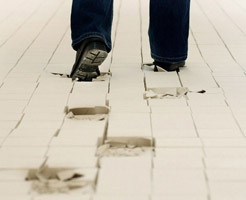A Secret History of Clay, 2004 - TATE Liverpool
‘Consciousness/Conscience’ - Tate, Liverpool; Crafts Council, London; and Icheon, Korea
Consciousness/Conscience is a ceramic installation that is destroyed; it is made from one of the most precious and revered materials in the clay spectrum, Bone China. It focuses on the creation and destruction of the work itself: the work is an installation intended for walking over by the public to enable them to view other works in the gallery space. The crushed boxes trace the pattern of activity in the same way tracks are recorded in snow. Seven thousand hollow cast bone china tiles is a lot of making for an individual crafts person; to maintain a constant form without deviation would be taxing for the individual maker. Royal Crown Derby provided the necessary sponsorship and collaboration; the project had to be undertaken by a company that would understand multiples and production to very refined requirements.
This work has been exhibited in Korea at the opening of The World Ceramics Biennale , The Crafts Council London and TATE Liverpool. These exhibitions have furthered the development of this work in their different use of the gallery space and the nature of their audience’s interaction.
‘Consciousness/Conscience’ - Tate, Liverpool; Crafts Council, London; and Icheon, Korea
Why does someone laboriously construct a sculpture with the full expectation that it will be walked all over and destroyed? Not only that, but have it destroyed in a gallery which usually shows objects which are highly crafted and treasured for their physical beauty?
Clare Twomey’s floor-piece is made up of hundreds of carefully made ceramic boxes. She has spent a great deal of time researching their material construction, dimensions, wall-thickness, ceramic type and firing time to get them to break exactly as she wants. She has sourced a manufacturer to produce sufficient quantity for the floor to be completely re-laid a number of times during the show. So I think it’s safe to say that this is not simply a gesture of irreverence.
Her very serious intentions are manifold but the most important in the context of this exhibition is to focus attention on the moment of the work’s reception. To shift attention from the work itself to how the viewer responds to the work.
It is possible to remain outside of the discreet space in which the floor-piece is laid, but immediately you walk into it and the ceramic breaks under your feet, your status is changed and you become a participant, activating the work, and the decisions you make start to affect the physical make-up and appearance of the piece. Twomey’s role as maker has undergone a subtle shift. She is now more akin to the position of the composer who sets the parameters of a musical composition down as a score, but gives the business of interpretation over to the players.
The breaking of China is usually a moment for regret, and in the case of a much-used and well-loved domestic item one of great sadness. Twomey though, is excited by the ephemeral nature of her material and takes pleasure in its fragility, giving the breaking of it the same exhilarating possibilities encountered on walking over virgin snow.
Mark Currah, 2003









